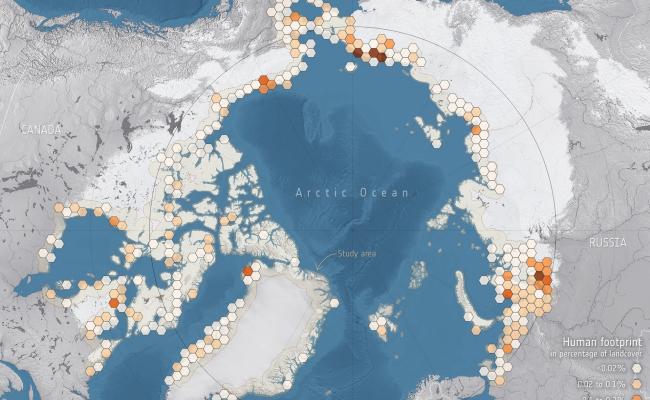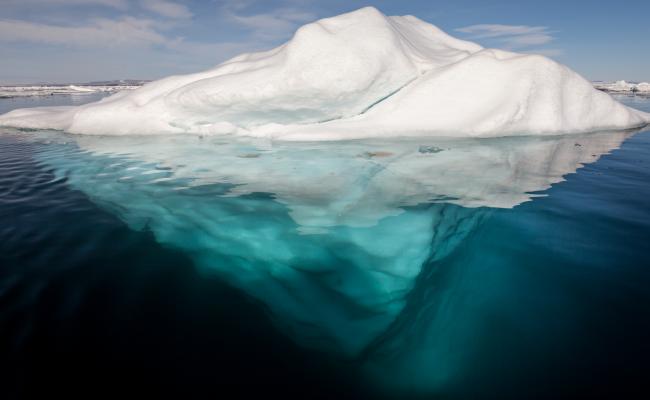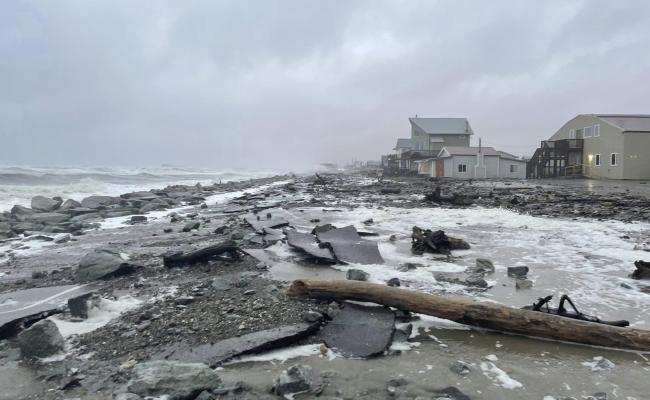A Warmer, Wetter, and Stormier Arctic As Result of Climate Change New Report Finds
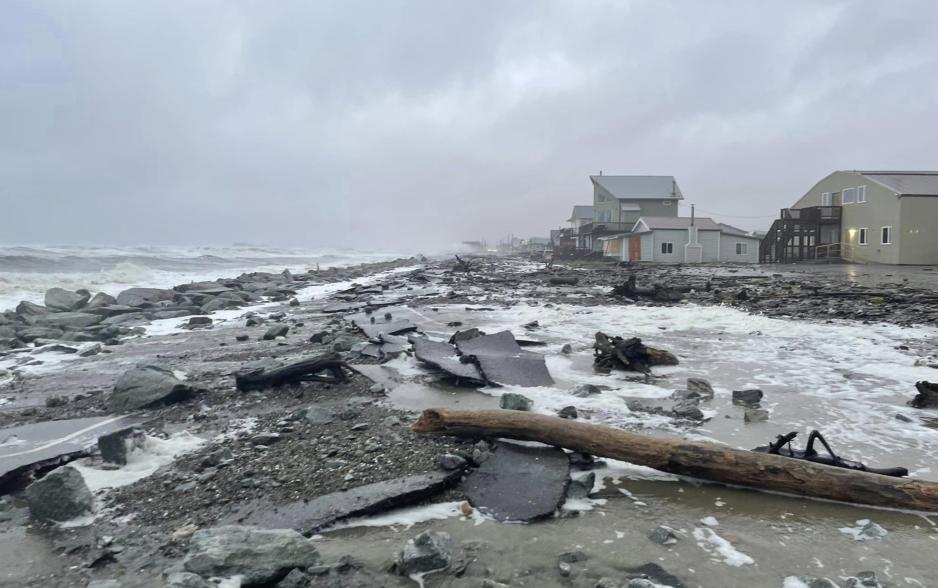
Flooding and destroyed roadway along coastline in Nome, Alaska. (Source: With permission by Jeremy Perkins)
NOAA's Annual Arctic Report Card provides a detailed picture of the rapid environmental changes the region is facing and for the first time highlights indigenous observations and knowledge.
In its latest annual Arctic Report Card, the US National Oceanic and Atmospheric Administration (NOAA) paints an increasingly bleak picture of the environmental changes the Arctic is facing.
A region which was previously synonymous with reliable snow and ice cover continues to heat up faster than any other region in the world and now faces extreme weather events – including typhoons, smoke from fires and rain events – seldomly associated with the high north.
NOAA’s annual report card for the region, first published in 2005, offers a stark chronology of how environmental changes have become increasingly dramatic over the 17-year history of the report.
This latest issue places a particular emphasis on and how the dramatic changes are affecting local and indigenous people and how communities are addressing the changes.
For this purpose the report card for the first time features a comprehensive chapter authored in part by Native Alaskan scientists.
Also read
Indigenous knowledge
The chapter provides a detailed account of how rising air temperatures and sea levels, declining sea ice and shorter winters, increasing risk of wildfires, and changes in seasonal patterns affect the “safety, food security, health, economic wellbeing and cultural traditions” of Indigenous people.
“Living and innovating in Arctic environments over millennia, Indigenous peoples have evolved holistic knowledge that provides resilience and sustainability,” says Jackie Qatalina Schaeffer, a co-author of the chapter, Director of Climate Initiatives for the Alaska Native Tribal Health Consortium and an Inupiaq from Kotzebue, Alaska.
Addressing and finding solutions for the changes facing Arctic communities is a complex challenge, Schaeffer says.
“Addressing the unprecedented environmental change requires listening to one another, aligning values and collaborating together as communities, businesses, governments, Indigenous and non-Indigenous scientists and decision-makers.”
The new chapter also highlights the urgency of building a “climate-ready nation” especially in a region that is on the front lines of climate change, explains NOAA Administrator Rick Spinrad.
Rapid warming in the Arctic is profoundly affecting more than 400,000 Indigenous people.
“With this important new chapter and other timely additions, the 2022 Arctic Report Card underscores the urgency to confront the climate crisis by reducing greenhouse gasses and taking steps to be more resilient.”
“I can’t overstate this but rapid warming in the Arctic is profoundly affecting more than 400,000 Indigenous people who live there, and in many instances is upending their entire way of life,” Spinrad emphasizes.
Arctic metrics not encouraging
The report also compiled a number of metrics to illustrate the dramatic changes the region is undergoing.
The seven warmest years in the region since record-keeping started in 1900, have occurred in the past seven years, and 2022 was the sixth warmest year on record in the Arctic.
Research indicates that the region continues to warm and acidify at four times the rate of the rest of the planet.
Some parts of the Arctic experienced average temperatures in 2022 more than 2.2 degree Celsius above the long-term median, well above the stated international goal of limiting warming across the globe to 1.5 degrees.
Also read
A similar trend of above-average warming can be observed in sea surface temperatures with the warming trend observed since 1982 continuing. Summer water temperatures are now between 2-3 degrees Celsius above the 1991-2020 average
While ice extent did not see new record-lows it remains well below averages of the 1980s and 1990s, with only around 50 percent of summer ice remaining compared to those decades.
Older, multi-year ice which is crucial to maintain ice cover during the warmer summer months and was once abundant throughout the Arctic Ocean, has now become extremely rare. The ocean also refreezes much later during Fall than it did decades ago.
In addition to more irregular snowfall, shorter winters and higher precipitation in the form of rain, the Arctic is also affected by climatic changes outside the region. Powerful Typhoon Merbok, which hit western Alaska in mid-September was rendered more powerful by unusually warm waters in the northern Pacific.
International cooperation
Outside of Alaska-specific changes the report highlights ongoing ice sheet loss in Greenland, which has now experienced its 25th consecutive year of ice loss.
During Fall 2022 an unusual warming event led to late-season melt across 36 percent of the island’s ice sheet, including at the ice sheet’s highest point at 10,500 feet.
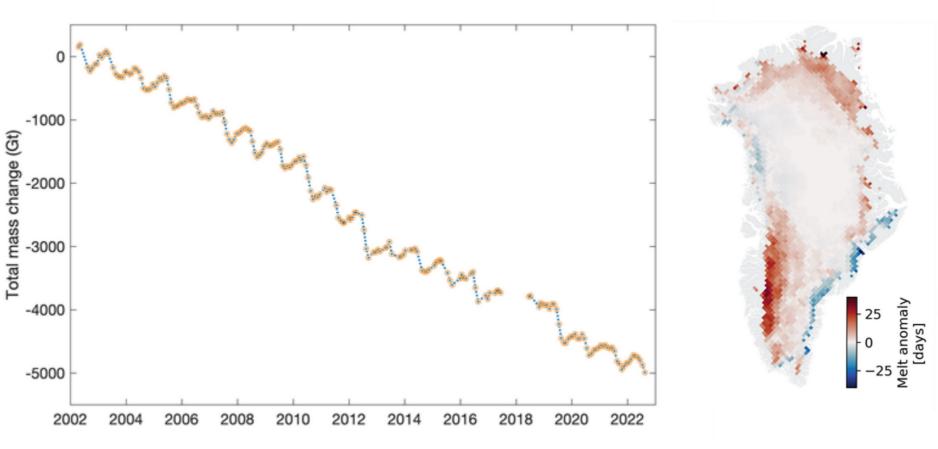
Left: Total mass change (Gt) of the Greenland ice sheet from April 2002 to mid-August 2022. Right: 2022 melt anomaly (in number of melting days; including data through 24 October 2022) with respect to the 1991-2020 reference period. (Source: NOAA Arctic Report Card)
The report also emphasizes the need for international cooperation to better and fully understand the changes and challenges the region faces and to identify and implement solutions.
“The Arctic remains a varied and expansive region to monitor, especially as widespread disturbances unfold and seasons shift,” explains Matthew Druckenmiller, a research scientist with the National Snow and Ice Data Center and the lead editor of the 2022 Arctic Report Card.
“To understand its transition, we need local to international partnerships, especially with Arctic peoples and Indigenous communities, who are vital to the use of diverse observations and knowledge, as well as to identifying solutions to long-term climate impacts and abrupt disturbances.”


